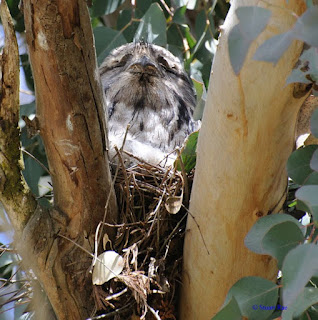
Over the weekend I was at the Weddin Mountains assisting with a long-term study of birds in the area. John Rawsthorne was organising the trip this time and Richard Allen who has been running the study for many years now was also there.
Several of us camped for the weekend and caught birds in mist nets set in the woodland at the base of the hills. Once caught we banded them so that they can be individually identified when caught in later years.
Here a dusky woodswallow is being fitted with a band.

Once banded, the birds were all measured and if possible their sex and age established from such features as their plumage colouring or size. Here the length of a woodswallow's head and bill are being measured very precisely.

One of the more abundant birds at the site were rufous whistlers, especially adult females like the one shown below.

Much of the land is still dry following the recent drought. Although the vegetation had grown well this spring after the rains, many birds were still not breeding. The bird on the left below is an adult brown-headed honey-eater, that on the right is a juvenile. Note the colour differences and the young bird's yellow gape. These birds are co-operative breeders - they live in extended family groups where they all help to rear the chicks. As can be seen, these are small birds, yet some of those which we caught had been banded several years ago. One bird was more than ten years old and another more than 14. Many Australian bird species seem to have adopted a strategy of long life and not necessarily breeding every year - unlike, for example, many northern European species which have short lives and breed every year. The former life-plan has perhaps evolved as an efficient method for maintaining a population through periods of drought.
Often, when a male bird cannot find a mate, he will sing all day long trying to attract one to his territory. This hooded robin was doing this, his whistle sounding to me much like that of a green woodpecker.
One of our party was Bill Mannan, visiting from Arizona where he studies Coopers Hawks. Here he is with a male collared sparrowhawk which we caught.







